|
Agriculture > Vegetables
> Brinjal (Solanum melongena L.)
|
|
|
|
About the crop
|
|
Brinjal (Solanum melongena L.) is one of the
most common vegetables grown throughout the country for its purple, green or white
pendulous fruit. It is a member of the Solanaceae family and is closely related
to tomato and potato. Aubergine is the British name for brinjal and in United States,
Australia and Canada, it is known by the name eggplant, because fruits of the earlier
cultivars resembled eggs of goose or hen.
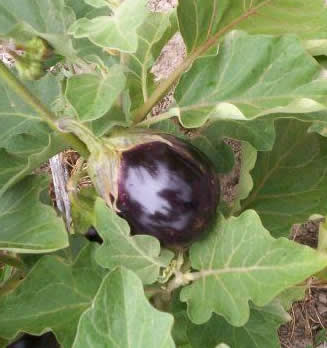
Brinjal is an erect annual plant, often spiny, with large, coarsely lobed fuzzy
leaves, 10-20 cm long and 5-10 cm broad. The plants usually grow 45 to 60 cm high
and bears long to oval shaped, purple or greenish fruits. Flowers are white to purple,
with five-lobed corolla and yellow stamens. The fruit is a fleshy berry, containing
numerous small, soft seeds.
Origin & distribution
Brinjal is a native of India and Sri Lanka. The ancestors of brinjal grew
wild in south India and were in cultivation in southern and eastern Asian countries
since prehistoric times. Although it has a long and rich history, brinjal did not
always hold the revered place in food culture that it does today. At one time
brinjal had a bitter and inauspicious reputation of being able to cause insanity,
leprosy and cancer, and it was even believed to be poisonous; and hence was used
more as a garden plant than as a food in many parts of the world. But it was only
in the 18th century, after the evolution of less bitter varieties, brinjal
lose its bitter taste and bitter reputation to gain its now esteemed place in the
cuisines. Today, Italy, Turkey, Egypt, China and Japan are the leading growers of
brinjal. In India, it is a popular vegetable crop of southern states and is also
cultivated in certain parts of Maharashtra, Gujarat and Uttar Pradesh.
Top
|
|
Climate & Soil
|
|
|
|
Brinjal is a warm season crop and requires a long warm growing season. But, it can
be successfully grown as a rainy season and summer season crop and can be cultivated
even at an elevation of 1200 m above MSL. However, the crop is very susceptible
to frost and crop growth is severely affected when temperature falls below 17°C.
Brinjal can be grown on all types of soils. However, it grows best in loose, friable,
well-drained silt loam or clay loam soils rich in organic matter. An early crop
gives good yield in light soils. The crop is moderately tolerant to acidic soils
and a pH range of 6.0-6.8 is considered optimum for its growth and development.
Top
|
|
Varieties
|
|
|
Surya
Bacterial wilt resistant, open pollinated, high yielding brinjal variety released
from the Kerala Agricultural University (KAU). Fruits are medium sized, oval, and
glossy violet with average fruit weight of 90 g. Average yield is 30 t/ha.
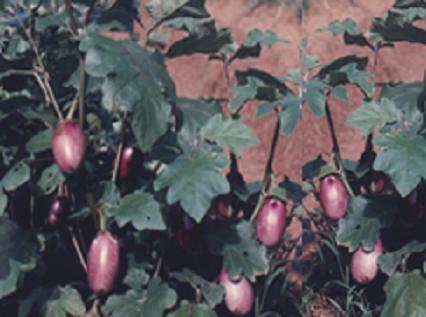
Swetha
Bacterial wilt resistant, open pollinated, high yielding brinjal variety released
from the KAU. Medium long, white fruits weighing 43 g on an average. Average yield
is 30 t/ha.
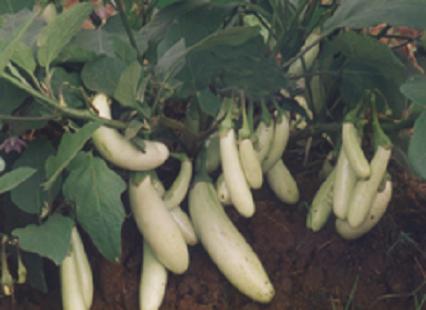
Haritha
Bacterial wilt resistant, open pollinated, high yielding brinjal variety released
from the KAU. Crop duration 2 years and average yield is 62 t/ha. Light green and
long fruits with average fruit weight of 123g.
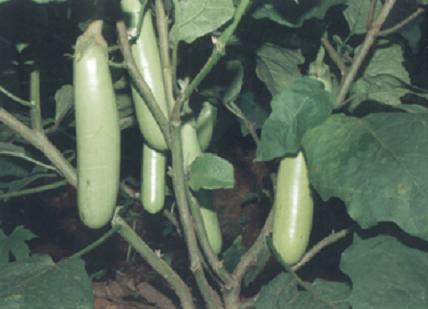
Neelima
First wilt resistant F1 hybrid brinjal in India released from the KAU. Large, oval
to round, and glossy violet fruits. Average fruit weight 176.0 g. Average yield
is 65 t/ha.

Pusa Purple Long
Released from IARI, New Delhi. Early maturing and long fruited variety suitable
for spring and autumn plantings. Fruits are 25-30 cm long, smooth glossy and tender,
and light purple in colour. Can be harvested from 100 to 110 days after planting.
Average yield is 27.5 t/ha. Moderately tolerant to shoot borer and little leaf disease.
Pusa Purple Cluster
Released from IARI, New Delhi. Early maturing and long fruited type. Fruits are
small, dark purple in colour and borne in clusters. The crop is ready for picking
in 75 days after transplanting. Resistant to little leaf disease under natural conditions.
Pusa Kranti
Released from IARI, New Delhi. The variety has a dwarf and spreading growth habit.
Fruits are oblong and stocky with attractive dark purple colour. Good for both spring
and autumn plantings. Crop matures in 130-150 days. Average yield is 14-16 t/ha.
Pusa Barsati
Released from PAU, Ludhiana. The variety has a dwarf and erect growth habit and
is devoid of thorns. Fruits are medium-long and purple with average yield 35.5 t/ha.
Manjri Gota
Released from MPKV, Rahuri, Maharashtra. The variety has a dwarf and spreading growth
habit. The fruits are medium-large, round, and purple coloured with white stripes.
Upon maturity, fruits attain a golden yellow colour. Average yield is 15-20 t/ha.
Vaishali
Released from MPKV, Rahuri, Maharashtra. The variety has a dwarf and spreading type
of growth habit. Fruits are oval in shape, and purple in colour with white stripes.
The stalks of the fruits bear spines. Crop is ready for first picking within 60
days after transplanting. Average yield is 30 t/ha.
Arka Navneet
A high yielding hybrid released from IIHR, Bangalore. Fruits are large oval to oblong
with deep purple and shining skin with each fruit 450 g in weight. Flowers are purple
with solitary bearing habit. Fruits are free from bitter principles and possess
very good cooking qualities. Crop is ready for picking in 150-160 days. Average
yield is 65-70 t/ha.
Arka Sheel
Released from IIHR, Bangalore. Fruits are medium long with deep shining purple skin.
Flowers are purple with solitary bearing habit. Crop is ready for picking in 150-160
days. Average yield is 38 t/ha.
Arka Kusmukar
Released from IIHR, Bangalore. Spreading plant habit with green stem and green leaves.
Flowers are white or green and fruits small and borne in cluster. Fruits are soft
textured with good cooking quality. Crop is ready for picking in 140-150 days. Average
yield is 40 t/ha.
Arka Nidhi
Released from IIHR, Bangalore. High yielding variety resistant to bacterial wilt.
Fruits are borne in cluster. Fruits are free from bitter principles with slow seed
maturity and good cooking quality. Crop is ready for picking in 150 days. Average
yield is 48 t/ha.
Arka Keshav
Released from IIHR, Bangalore. High yielding bacterial wilt resistant variety. Fruits
are tender, free from bitter principles with seed maturity. Crop is ready for picking
in 150 days. Average yield is 45 t/ha.
Arka Neelkanth
Released from IIHR, Bangalore. High yielding variety with bacterial wilt resistance.
Fruits tender, free from bitter principles. Crop is ready for picking in 150 days.
Average yield is 43 t/ha.
Pusa Ankur
Released from IARI, New Delhi. Fruits are oval-round and small sized weighing 60-80g.
Fruits are dark purple, oval to round, and glossy. It is an early bearing variety
and becomes ready for first picking 45 days after transplanting. Its fruits do not
lose color and tenderness even on delayed pickings.
Top
|
|
Propagation & Planting
|
|
|
Seed rate
About 370-500 g of seed are sufficient for raising seedlings for one hectare of
land.
Raising seedlings
Brinjal is a transplanted vegetable. Seeds are sown in the nursery and one month
old seedlings are transplanted to the main field. For sowing the seeds, raised seedbeds
of 90 to 100 cm width and convenient length are prepared in open space with fertile
topsoil to which well-decomposed organic matter has been incorporated. Solarization of
nursery beds for 30 days prior to sowing is effective in managing dampinf off. Prior to
sowing, treat the seeds with fungal culture of Trichoderma viride @ 4 g/kg
of seed to avoid damage from damping off disease. Sowing
should be done thinly in lines spaced at 5-7 cm distance at a depth of 2-3 cm and
covered with a fine layer of soil followed by mulching with green leaves. After
sowing the seeds, irrigate with a rose-can daily in the morning. To avoid mortality
of seedlings due to damping off, drenching of the beds with Bavistin @1.5-2.0 g/litre
is effective. Remove the mulch immediately after germination of the seeds. Harden
the seedling one week before transplanting by withholding irrigation, and irrigate
profusely on the previous day of transplanting. The seedlings are ready for transplanting
within 4-6 weeks of planting when they attain a height of 15 cm with 2-3 true leaves.Portray seedlings
can also be used.
Time of planting
For rainfed crop, transplant the seedlings during May-June before the onset of south
west monsoon. Planting can also be done during September-October for irrigated crop.
Land preparation and transplanting
Prepare the land to a fine tilth by thorough ploughing, incorporate well-rotten
organic manure and level the land by planking. Seedlings are transplanted in shallow
trenches or pits during summer season and on ridges or level land during rainy season.
A pre-sowing irrigation is given 3-4 days prior to transplanting. At the time of
transplanting, roots of the seedlings should be dipped in a solution of Bavistin
@ 2 g/litre. Transplanting should preferably be done in the evening and seedlings
may be given temporary shade for 3-4 days during summer.
Spacing
Spacing depends upon the variety and season of planting. Transplant less spreading
varieties like Swetha and Surya at 60 x 60 cm. For spreading varieties
like Haritha and Neelima, provide wider spacing of 75-90 x 60
cm.
Top
|
|
Intercultural Operations
|
|
|
Manuring
Apply well rotten FYM or compost @ 20-25 t/ha at the time of land preparation and
mix well with the soil. A fertilizer dose of 75:40:25 kg N:P2O5:
K2O / ha may be given. Half the dose of nitrogen, full phosphorus and
half of potash may be applied as basal dose before transplanting. One fourth of
nitrogen and half of potash may be applied 20-30 days after planting. The remaining
quantities may be applied two months after planting. Application of 75:25:25 kg
N:P2O5:K2O /ha is optimum for getting maximum yield
of fruits for the variety Swetha in the reclaimed alluvial soils of Kuttanad.
However, the economic optimum dose was found to be 60:20:25 kg of N:P2O5:K2O
/ ha.
Weeding and intercultural operations
The field should be kept weed-free, especially in the initial stage of plant growth,
as weeds compete with the crop and reduce the yield drastically. Frequent shallow
cultivation should be done at regular interval so as to keep the field free from
weeds and to facilitate soil aeration and proper root development. Deep cultivation
should be avoided as it injures the root system and expose moist soil to the surface.
Weeding followed by fertilizer application and earthing up may be done one and two
months after transplanting. Pre-emergence application of fluchloralin @ 1.5 kg a.i./ha
coupled with hand weeding once (30 days after transplanting) is also effective for
controlling weeds.
Irrigation
Continuous supply of moisture should be maintained around the root zone of the plant.
A light irrigation is given on the first and third day after transplanting. Irrigate
at three or four days interval during summer. Stake the plants if necessary.
Top
|
|
Plant Protection
|
|
|
Pests
Shoot and fruit borer (Leucinodes orbonalis)
Shoot and fruit borer causes serious damage to the crop leading to severe reduction
in yield. Short pinkish larva of the pest initially bores into the terminal shoots
resulting in withering and drying up of the shoot. In the later stage, it bores
into the young fruits by making holes and feeding from within thereby making the
fruits unfit for consumption. Attacked fruits rot in severe case.
Control: Continuous cropping of
brinjal on the same field should be avoided. As soon as the pest attack is noted,
remove and destroy the affected parts along with the insect. Fruits showing any
boring symptom should also be picked and destroyed.
Spay Emamectin benzoate 5% SG @ 10 g ai/ha or Chloran tranilipole 18.5 SC @ 30 g ai/ha at
an interval of 15 days to control fruit and shoot borer under large scale cultivation.
Leaf eating beetle (Epilachna vigintioctopunctata)
The yellowish coloured grubs and adults of the beetle feed voraciously on leaves
and tender plant parts, and the leaves are completely skeletonized leaving only
a network of veins. When in large number, the pest causes serious defoliation and
reduces yield.
Control: Collection and destruction
of infested leaves along with the grubs, adults and eggs reduces damage to the crop.
Spraying malathion (2 ml/litre of water) or carbaryl (2-4 g/litre of water) effectively
controls the pest.
Jassids (Amrasca biguttula biguttula,
Cestius phycitis)
Both nymph and adult stages of jassids suck sap from the lower surface of the leaves.
The infested leaves curl upward along the margin, which may later turn yellowish,
and show burnt up patches. Fruit set is adversely affected by the infestation. Jassids
are the vectors of mycoplasmal and viral diseases like little leaf and mosaic.
Control:
Spray Thiamethoxam 25 WG @ 50 g ai/ha or Diafenthiuron 50 WP @
300 ai/ha or Spiromesifen 22.9 SC @ 96 g ai /ha.
Leaf roller (Eublemma olivacea)
Caterpillars of the leaf roller pest roll the leaves and feed on green matter while
remaining inside the folds. The folded leaves wither and dry up.
Control: Collection and destruction
of the infested leaves along with the insects in the initial stage itself help to
minimize damage to the crop. Spraying carbaryl (0.1%) or malathion (0.05%) controls
the pest effectively.
Red spider mite (Tetranychus neocaledonicus,
T. cinnabarinus, Paratetranychus indicus)
Nymphs and adults of the mites suck cell sap and white patches appear on leaves.
Affected leaves become mottled, turn brown and fall. Different stages of mites are
found in colonies covered by white silky webs on lower surface of leaves. High temperature
and low relative humidity are conducive for multiplication of mites.
Control: Acaricides like dicofol
(0.05%) and wettable sulphur (0.3%) gives effective control of mites. At high temperatures,
it may be necessary to apply these at an interval of two days. However, during egg
stage and the resting stages, most acaricides are ineffective. Collection and burning
of severely infested plant parts reduces further multiplication of mites. Proper
irrigation and clean cultivation are essential to keep the pest population under
control.
Mealy bug (Centrocccus insolitus)
Nymphs and adults of mealy bugs suck sap from the leaves, tender shoots, and the
fruits. Leaves show characteristic curling symptoms similar to that of a virus attack.
Heavy black sooty mould may develop on the honeydew like droplets secreted by mealy
bugs. If the flower blooms are attacked, the fruit set is affected. When the fruits
are infested, it may lead to fruit drop or the fruits remain on the shoots in a
dried and shriveled condition.
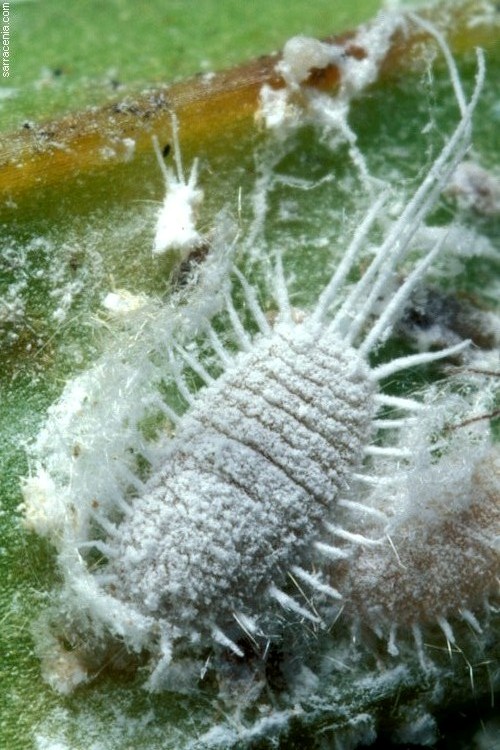
Control: Spraying insecticides like
dichlorvos (0.02%) or chlorpyriphos (0.05%) with fish oil rosin soap control the
insect population. Unlike the adults, the crawlers are free from waxy coating and
therefore the crawler stage is the most effective stage for spraying pesticides.
Root knot nematodes (Meloidogyne incognita
and M. javanica)
The root knot nematode damage is more harmful to seedlings than to older plants.
The affected plants show the development of galls on the roots. The plants become
stunted and the leaves show chlorotic symptoms. Fruit set is adversely affected.
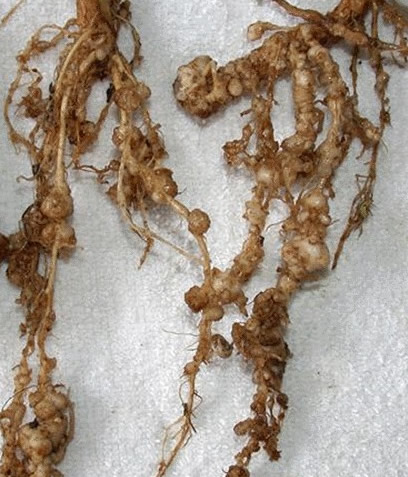
Control: Crop rotation with root
knot nematode resistant crops like marigold, etc. help in the reduction of nematode
population.
Nursery treatment with Bacillus macerans or Paecilliomyces lilacinus @ 25 g/m2 and
mainfield treatment with P. lilacinus @ 5 g/m2 can be recommended.
Diseases
Damping off (Pythium spp., Phytophthora
spp., Rhizoctonia spp.)
A serious disease in the nursery. High soil moisture and moderate temperature along
with high humidity especially in the rainy season favour the disease. Two types
of symptoms are observed, viz., pre emergent and post emergent damping off. The
pre emergent damping off results in rotting of seed and seedling before emerging
out of soil. Whereas in the post emergent damping off, seedlings after emergence
are infected near the collar region at ground level. The infected tissues become
soft and water soaked. The collar portion rots and ultimately the seedlings collapse
and die.
Control: For avoiding damping off
in the nursery, sow the seeds as thin as possible in the raised beds prepared in
the open area during summer months.Soil solarisation of nursery buds for 30 days prior
to sowing and seed treatment with Trichoderma @ 5 g/kg is effective in managing the
disease. Healthy seeds should be selected for sowing
and should be treated with Thiram @ 2g/kg of seed before sowing. Continuous raising
of nursery in the same plot should be avoided. The topsoil of nursery should be
treated with Thiram @ 5g/sq m area of the soil and nursery should be drenched with
the same chemical @ 2g/litre of water at fortnightly interval. Soil solarization
by spreading 250 gauge polythene sheet over the bed for 30 days before sowing and
application of bio-control agent Trichoderma viride in soil @ 1.2 kg/ha
is also found effective to considerable extent.
Phomopsis blight (Phomopsis vexans)
It is a serious disease of brinjal infecting the foliage and the fruits. The fungus
infects the seedlings in the nursery causing damping off symptoms. When the leaves
are infected, small circular spots appear which later become grey to brown with
irregular blackish margins. Symptoms on fruits appear as minute, sunken dull and
dusky spots, which later merge and the infected fruits rot.
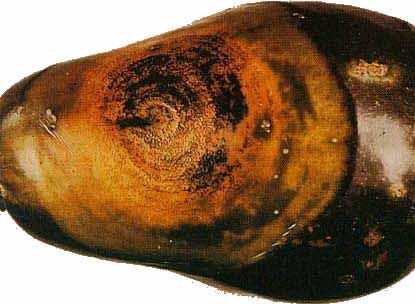
Control: Adopting good field sanitation,
destruction of infected plant material and crop rotation help to reduce the spread
of the disease. Seeds obtained from disease free plants should be used for planting.
Seed treatment with Thiram (2 g/kg seed) protects the seedling in the nursery stage.
Spraying with Dithane Z-78 (0.2%) or Bordeaux mixture (1%) effectively controls
the disease in the field.
Fruit rot (Phytophthora nicotianae)
The symptoms first appear as small water soaked lesions on the fruit, which later
enlarges in size considerably. Skin of infected fruit turns brown and develops white
cottony growth. High humidity favours the development of the disease.
Control: Removal and destruction
of the affected fruits and spraying the crop with Dithane M-45 (0.3%) thrice at
an interval of 10 days effectively controls the disease.
Verticillium wilt (Verticilium dahliae)
All stages of the crop are susceptible to the disease. The infected young plants
show dwarfing and stunting due to the shortening of the internodes. Such plants
do not flower and fruit. Infection after the flowering stage results in development
of distorted floral buds and fruits. The affected fruits finally drop off. Infected
leaves show the presence of irregularly scattered necrotic pale yellow spots over
the leaf lamina. Later on, these spots coalesce resulting in complete wilting of
the leaves.
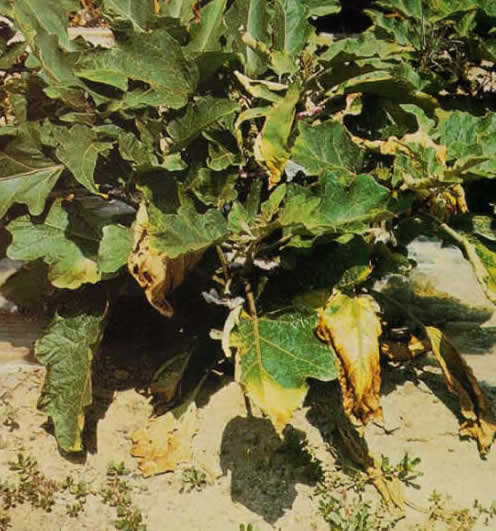
Control: Crop rotation with bhindi,
tomato, potato should be avoided. Soil application and foliar application with bavisin
(0.1%) is effective in reducing the wilt disease.
Bacterial wilt (Psedomonas solancearum)
Bacterial wilt disease is a serious problem for brinjal cultivation in Kerala. The
characteristic symptoms of the disease include wilting of the foliage followed by
collapse of the entire plant. The wilting is characterized by gradual yellowing,
withering and drying of the entire plant or some of its branches.
Control: Removal and destruction
of affected plants and using disease resistant varieties like Surya, Swetha
and Haritha and the hybrid Neelima in bacterial wilt prone areas
help to reduce the disease incidence. Crop rotation with bhindi, tomato, potato
should be avoided. Before sowing the seeds should be dipped in a solution of streptocycline
(1 g/ 40 litres of water) for 30 minutes.
Little leaf of brinjal
A viral disease of brinjal transmitted by leafhoppers. Leaves of the infected plants
are small and malformed with light yellow colouration. Infected plants show stunted
growth with shorter internodes and petioles, and large number of branches and roots
than normal giving the plant a bushy appearance. Flower parts are deformed and sterile
and do not normally bear fruits, and if fruits are formed they will be hard and
tough and will fail to mature.
Control: Adopting sanitary measures
like early removal and destruction of infected plants and eradication of susceptible
volunteer crop plants of the previous season can reduce the damage. Use of barriers
of trap crops and adjusting sowing time to avoid the main flights of leafhopper
vector is also recommended. Spraying malathion (2 ml/litre of water) starting with
the appearance of the leafhoppers controls their population.
Mosaic
A viral disease caused by Potato Virus Y and transmitted by aphids like Aphis gossypi
and Myzus persicae. Characteristic symptoms of the disease are mosaic mottling
of the leaves and stunted growth of the plant when infected in the early stages.
The leaves of infected plants are deformed, small and leathery.
Control: The disease incidence can
be minimised by reducing the population of aphids, removal and destruction of infected
plants and eradication of susceptible weed hosts.
Top
|
|
Harvesting
|
|
|
|
The fruits become ready for first picking in about 60-160 days after transplanting
depending on the variety. Varieties with elongated fruits take more time to ripen.
Harvesting at correct maturity is important, as over mature brinjal fruits turn
pithy and bitter. Harvest the fruits when they attain good size and become greenish
yellow or bronze in colour and skin is glossy, but before seeds begin to enlarge
significantly and mature. Pressing the thumb against the side of the fruit can indicate
the maturity of the fruit. If the pressed portion springs back to its original shape,
the fruit is too immature. Harvest using a sharp knife rather than by pulling by
hand, and retain some portion of the calyx and the stem end on the fruit. Since
all the fruits do not mature at the same time, the fruits are harvested at an interval
of 8-10 days. Regular harvesting also encourage continued fruit set. In some varieties,
a second phase of harvesting is obtained 20-25 days after the first spell, if adequate
nutrition and irrigation are provided. The crop can be removed after 110 days if
the 2nd flush is not desired, otherwise it can be retained for 150-160
days. Depending on variety and season the average yield of brinjal varies from 20-30
t/ha.
Careful harvesting and handling practices should be followed to avoid bruising and
compression of brinjal fruits. The harvested fruits should be pre cooled immediately
to reduce water loss. For this the fruits are washed and cooled by dumping in a
water bath prior to packing. Brinjal has a very short shelf life, usually fewer
than 14 days. Decay sets in when fruits are stored more than two weeks, and symptoms
of water loss like skin wrinkling, spongy flesh, browning of the calyx, and reduction
in surface sheen would appear. Symptoms of chilling injury include fruit and calyx
discolouration, surface pitting, internal discoloration of the pulp and seeds, off
odor and fruit decay.
Uses
As a native plant, brinjal is widely used in the South Indian cuisine like sambhars,
chutneys, curries, and kootus. It can be baked, stewed, fried,
or added to soups, curries, etc. The brinjal can also be stuffed with meat, rice
or other fillings and then baked. Owing to its versatile nature and wide use, in
both everyday and festive South Indian food, it is often described as the 'King
of Vegetables' in South India.
Nutritional and health aspects
Nutritionally, brinjal is low in energy (30 kcal/100g), protein (1.2%) and vitamin
C (5 mg/100g), but is a very good source of dietary fibre, potassium, calcium, manganese,
copper and thiamin (vitamin B1). High potassium content helps to maintain good hydration
and regulate blood pressure. They are also a good source of vitamin B6, folate,
magnesium and niacin.
In addition to featuring a host of vitamins and minerals, brinjal contains important
phytonutrients, many of which are phenolic compounds that function as antioxidants,
the predominant one being chlorogenic acid. Chlorogenic acid is one of the most
potent free radical scavengers found in plant tissues and has proven anti-cancerous,
antimicrobial, anti LDL (bad cholesterol) and antiviral activities. Brinjal also
contains flavonoid namely nasunin, which is also a potent antioxidant and
free radical scavenger and protects brain cell membranes. Nasunin
also binds with the excess iron and remove it from the body, by a process known
as chelation. Although iron is an essential nutrient, excess of which is harmful
as it increases free radical production and increases risk of heart disease and
cancer. By chelating iron, nasunin lessens free radical formation thereby
lowering the risk of heart diseases, cancer and rheumatic arthritis.
Brinjal fruits also contain certain anti nutritional principles namely oxalates.
When oxalates become too concentrated in body fluids, they can crystallize and cause
health problems. For this reason, it is safe for individuals with kidney or gall
bladder problems to avoid eating brinjal.
Top
|
|